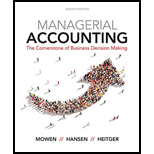
Concept explainers
Tonya Martin, CMA and controller or the Parts Division of Gunderson Inc., was meeting with Doug Adams, manager of the division. The topic of discussion was the assignment of
Tonya: Doug, as you know, about 25% of our business is based on government contracts, with the other 75% based on jobs from private sources won through bidding. During the last several years, our private business has declined. We have been losing more bids than usual. After some careful investigation, I have concluded that we are overpricing some jobs because of improper assignment of overhead costs. Some jobs are also being underpriced. Unfortunately, the jobs being overpriced are coming from our higher-volume, labor-intensive products, so we are losing business.
Dong: I think I understand. Jobs associated with our high-volume products are being assigned more overhead than they should be receiving. Then when we add our standard 40% markup, we end up with a higher price than our competitors, who assign costs more accurately.
Tonya: Exactly. We have two producing departments, one labor-intensive and the other machine-intensive. The labor-intensive department generates much less overhead than the machine-intensive department. Furthermore, virtually all of our high-volume jobs are labor-intensive. We have been using a plantwide rate based on direct labor hours to assign overhead to all jobs. As a result, the high-volume, labor-intensive jobs receive a greater share of the machine-intensive department’s overhead than they deserve. This problem can be greatly alleviated by switching to departmental overhead rates. For example, an average high-volume job would be assigned $100,000 of overhead using a plantwide rate and only $70,000 using departmental rates. The change would lower our bidding price on high-volume jobs by an average of $42,000 per job. By increasing the accuracy of our product costing, we can make better pricing decisions and win back much of our private-sector business.
Doug: Sounds good. When can you implement the change in overhead rates?
Tonya: It won’t take long. I can have the new system working within four to six weeks—certainly by the start of the new fiscal year.
Doug: Hold it. I just thought of a possible complication. As I recall, most of our government contract work is done in the labor-intensive department. This new overhead assignment scheme will push down the cost on the government jobs, and we will lose revenues. They pay us full cost plus our standard markup. This business is not threatened by our current costing procedures, but we can’t switch our rates for only the private business. Government auditors would question the lack of consistency in our costing procedures.
Tonya: You do have a point. I thought of this issue also. According to my estimates, we will gain more revenues from the private sector than we will lose from our government contracts. Besides, the costs of our government jobs are distorted. In effect, we are overcharging the government.
Doug: They don’t know that and never would unless we switch our overhead assignment procedures. I think I have the solution. Officially, let’s keep our plantwide overhead rate. All of the official records will reflect this overhead costing approach for both our private and government business. Unofficially. I want you to develop a separate set of books that can be used to generate the information we need to prepare competitive bids for our private-sector business.
Required:
- 1. Do you believe that the solution proposed by Doug is ethical? Explain.
- 2. Suppose that Tonya decides that Doug’s solution is not right and objects strongly. Further suppose that, despite Tonya’s objections, Doug insists strongly on implementing the action. What should Tonya do?
Trending nowThis is a popular solution!

Chapter 4 Solutions
Managerial Accounting: The Cornerstone of Business Decision-Making
- ? Financial accounting questionarrow_forwardWhat was the amount of sales for the month?arrow_forwardMahesh Enterprises is solely owned and operated by John Mahesh. As of December 31, 2016, Mahesh Enterprises has assets of $875,400 and liabilities of $245,300. During 2017, John Mahesh purchased an additional $32,150 of capital stock and received $22,700 in cash dividends from the business. What is the net income of Mahesh Enterprises during 2017, assuming that as of December 31, 2017, assets were $940,500, and liabilities were $215,600?solve thisarrow_forward
- Tutor need your advicearrow_forwardNeed helparrow_forwardThe owner's equity in a business amounted to $76,000 at the beginning of the year and $135,000 at the end of the year. The owner had made no additional investments and had withdrawn $39,000 during the year. The net income for the year amounted to:arrow_forward
- Determine the materials price variancearrow_forwardHi experts please answer the financial accounting questionarrow_forwardOn January 1, 2017, Chintan Corp., a 75% owned subsidiary of Victor Inc., transferred equipment with a 10-year useful life to Victor Inc. in exchange for $95,000 cash. At the date of transfer, Chintan’s records carried the equipment at a cost of $140,000 with accumulated depreciation of $60,000. Straight-line depreciation is used. Chintan reported net income of $50,000 and $42,000 for 2017 and 2018, respectively. All net income effects of the intra-entity transfer are attributed to the seller for consolidation purposes. Compute the gain recognized by Chintan Corp. relating to the equipment for 2017.arrow_forward
 Managerial Accounting: The Cornerstone of Busines...AccountingISBN:9781337115773Author:Maryanne M. Mowen, Don R. Hansen, Dan L. HeitgerPublisher:Cengage Learning
Managerial Accounting: The Cornerstone of Busines...AccountingISBN:9781337115773Author:Maryanne M. Mowen, Don R. Hansen, Dan L. HeitgerPublisher:Cengage Learning Cornerstones of Cost Management (Cornerstones Ser...AccountingISBN:9781305970663Author:Don R. Hansen, Maryanne M. MowenPublisher:Cengage Learning
Cornerstones of Cost Management (Cornerstones Ser...AccountingISBN:9781305970663Author:Don R. Hansen, Maryanne M. MowenPublisher:Cengage Learning Managerial AccountingAccountingISBN:9781337912020Author:Carl Warren, Ph.d. Cma William B. TaylerPublisher:South-Western College Pub
Managerial AccountingAccountingISBN:9781337912020Author:Carl Warren, Ph.d. Cma William B. TaylerPublisher:South-Western College Pub Principles of Cost AccountingAccountingISBN:9781305087408Author:Edward J. Vanderbeck, Maria R. MitchellPublisher:Cengage Learning
Principles of Cost AccountingAccountingISBN:9781305087408Author:Edward J. Vanderbeck, Maria R. MitchellPublisher:Cengage Learning



